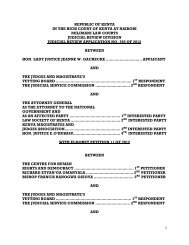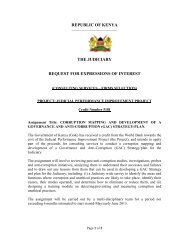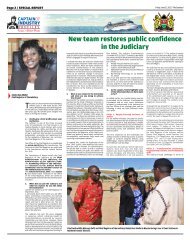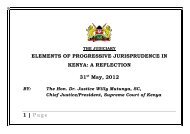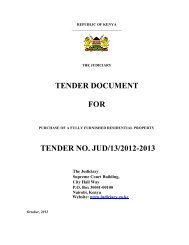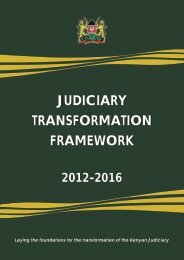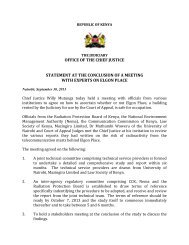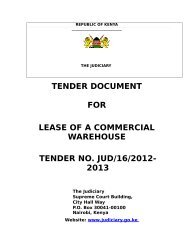Download PDF - The Judiciary
Download PDF - The Judiciary
Download PDF - The Judiciary
Create successful ePaper yourself
Turn your PDF publications into a flip-book with our unique Google optimized e-Paper software.
State of <strong>Judiciary</strong> 2011-2012<br />
17<br />
that many files recorded as pending were no longer active and<br />
could be closed. Although the backlog in the Environment and<br />
Land Division was 5,000, a baseline survey established that 16,907<br />
new cases had been filed between the year 2000 and 2011. Within<br />
100 days, the backlog had been reduced by 3,419 cases. In the<br />
Commercial and Admiralty Division, where a baseline survey<br />
surfaced 29,000 cases, some 27,000 cases were removed from the<br />
backlog. <strong>The</strong>re were similar initiatives in the Constitutional, Human<br />
Rights and Judicial Review, the Criminal and the Family divisions.<br />
Out of the 58,800 cases captured as backlog in these courts, 31,260<br />
were disposed of in just 100 days. In the Constitutional and Human<br />
Rights Division, a baseline survey surfaced 6,000 files and within 100<br />
days a total of 590 case had been cleared.<br />
<strong>The</strong> <strong>Judiciary</strong> is initiating a policy requiring that once proceedings<br />
begin, cases are heard back-to-back on a first filed, first heard basis.<br />
<strong>The</strong> office of the Chief Justice is enforcing deadlines on the writing<br />
of judgments and the hearing of cases. An electronic-based system<br />
will be used to track and monitor overdue judgments and rulings.<br />
1.3 Devolution<br />
Devolution and sharing of power is one of the national values and<br />
principles binding all State organs. Even though the constitutional<br />
architecture of the state places the <strong>Judiciary</strong>’s functions within<br />
the national government, the obligation to devolve is implied in<br />
these national values and principles. <strong>The</strong> <strong>Judiciary</strong> has innovated<br />
mechanisms -- through internal institutional organisation,<br />
recruitment, and delivery of services -- that allow communities<br />
across the country to be part of decision making and to facilitate<br />
more efficient delivery of services. Representation in the Court<br />
Users Committees is robust, and the recruitment of junior cadre<br />
staff has been devolved to the station level. Firms and community<br />
organisations are increasingly being encouraged to bid to provide<br />
supplies and services such as cleaning and security at the court<br />
station level.<br />
Over the past year, the <strong>Judiciary</strong> has coalesced court stations into<br />
17 administrative regions for efficient and effective administration<br />
(see Annex 2).





